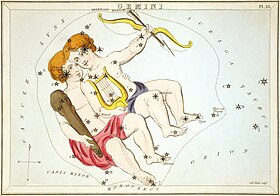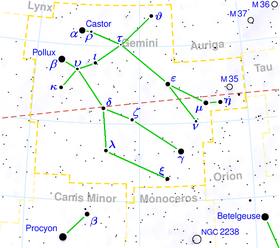Gemini (constellation)
| Constellation | |
 | |
| Abbreviation | Gem |
|---|---|
| Genitive | Geminorum |
| Pronunciation | /ˈdʒɛmɪnaɪ/ genitive /ˌdʒɛmɪˈnɒrəm/ |
| Symbolism | the Twins, Castor & Pollux |
| Right ascension | 7 |
| Declination | +20 |
| Quadrant | NQ2 |
| Area | 514 sq. deg. (30th) |
| Main stars | 8, 17 |
| Bayer/Flamsteed stars | 80 |
| Stars with planets | 8 |
| Stars brighter than 3.00m | 4 |
| Stars within 10.00 pc (32.62 ly) | 4 |
| Brightest star | Pollux (β Gem) (1.15m) |
| Messier objects | 1 |
| Meteor showers | Geminids Rho Geminids |
| Bordering constellations | Lynx Auriga Taurus Orion Monoceros Canis Minor Cancer |
| Visible at latitudes between +90° and −60°. Best visible at 21:00 (9 p.m.) during the month of February. | |
Gemini is one of the constellations of the zodiac. It was one of the 48 constellations described by the 2nd century AD astronomer Ptolemy. It is one of the 88 modern constellations today. Its name is Latin for "twins." It is from the twins Castor and Pollux in Greek mythology. Its symbol is ![]() (Unicode ♊).
(Unicode ♊).
Location
[change | change source]

Gemini lies between Taurus to the west and Cancer to the east. Auriga and Lynx are to the north. Monoceros and Canis Minor are to the south.
Meteor showers
[change | change source]The Geminids are a meteor shower that can be seen best on December 13–14. People watching it see about 100 meteors per hour at most. It one of the richest meteor showers.[3] The Epsilon Geminids peak between October 18 and October 29. They have only been recently confirmed. They overlap with the Orionids. This makes the Epsilon Geminids hard to see. Epsilon Geminid meteors move faster than Orionids.[4]
Mythology
[change | change source]
In Babylonian astronomy, the stars Castor and Pollux were known as the Great Twins (MUL.MASH.TAB.BA.GAL.GAL). The Twins were thought of as minor gods. They were called Meshlamtaea and Lugalirra. These names meant 'The One who has arisen from the Underworld' and the 'Mighty King'. Both names can be understood as titles of Nergal, the major Babylonian god of plague and pestilence. He was king of the Underworld.[5]
Visualizations
[change | change source]
Castor and Pollux are the brightest stars in Gemini. They are two bright stars that appear very close together forming an o shape.
Astrology
[change | change source]The Sun appears in the constellation Gemini from June 20 to July 20. In tropical astrology, the Sun is in the sign Gemini from May 21 to June 22, and in sidereal astrology, from June 16 to July 15.
References
[change | change source]- ↑ "K12.mi.us". Archived from the original on 2005-09-27. Retrieved 2014-09-16.
- ↑ Constellation drawings (often but not always) following "The Stars - A new way to see them", H.A. Rey, 1952–1980, ISBN 0-395-24830-2.
- ↑ Ridpath & Tirion 2001, pp. 150–152.
- ↑ Jenniskens, Peter (September 2012). "Mapping Meteoroid Orbits: New Meteor Showers Discovered". Sky & Telescope: 22.
- ↑ Babylonian Star-lore by Gavin White, Solaria Pubs, 2008, page 125
- Levy, David H. (2005). Deep Sky Objects. Prometheus Books. ISBN 1-59102-361-0.
- H. A. Rey, The Stars — A New Way To See Them. Enlarged World-Wide Edition. Houghton Mifflin, Boston, 1997. ISBN 0-395-24830-2.
- Ridpath, Ian; Tirion, Wil (2001), Stars and Planets Guide, Princeton University Press, ISBN 0-691-08913-2
- Ian Ridpath and Wil Tirion (2007). Stars and Planets Guide, Collins, London. ISBN 978-0-00-725120-9. Princeton University Press, Princeton. ISBN 978-0-691-13556-4.
Other websites
[change | change source]- The Deep Photographic Guide to the Constellations: Gemini
- Astrojan Astronomical Picture Collection Archived 2021-08-31 at the Wayback Machine: The clickable Gemini
- WikiSky: Gemini constellation
- Ian Ridpath's Star Tales: Gemini
- APOD Pictures of Gemini and Deep Sky Objects:
- A Spring Sky Over Hirsau Abbey
- The Eskimo Nebula from Hubble
- The Medusa Nebula
- Open Star Clusters M35 and NGC 2158
- NGC 2266: Old Cluster in the NGC
- Constellation Guide: Gemini Constellation
